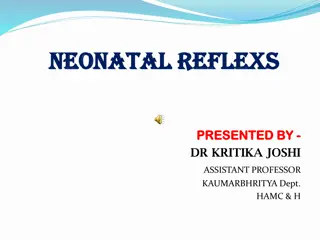Understanding Kangaroo Care for Babies: Benefits and Procedure
Kangaroo care is a method involving skin-to-skin contact where a baby is placed on a parent's bare chest. Developed in the late 1970s in response to high death rates in premature babies, this practice has numerous benefits for both babies and parents. It helps stabilize heart rate, improve breathing patterns, and strengthen the bond between parents and their newborns.
Download Presentation

Please find below an Image/Link to download the presentation.
The content on the website is provided AS IS for your information and personal use only. It may not be sold, licensed, or shared on other websites without obtaining consent from the author. Download presentation by click this link. If you encounter any issues during the download, it is possible that the publisher has removed the file from their server.
E N D
Presentation Transcript
StudyMafia.Org Kangaroo Care { Submitted To: Studymafia.org Studymafia.org Submitted By:
Table Contents Definition Introduction About Kangaroo care Benefits of Kangaroo care Why Kangaroo care Procedure of Kangaroo care Precautions of Kangaroo care Conclusion 2
Definition Kangaroo care is a method of holding a baby that involves skin-to-skin contact. The baby, who is typically naked except for a diaper, is placed in an upright position against a parent s bare chest. 3
Introduction Holding your baby closely to your chest is a special experience that can help build the bond between you and your new family member. This type of touch isn t just good for bonding it s also medically beneficial for your baby. Kangaroo care is a method of holding your baby to your chest. This allows for skin-to-skin contact between you and baby. During each session, your baby will be placed (naked except for a diaper and hat) on your chest (also bared to allow skin-to-skin) for up to a few hours. A blanket, shirt, hospital gown or robe can be wrapped around you and over your baby s back for warmth. 4
About Kangaroo care? Kangaroo care was developed in Bogota, Colombia in the late 1970s. This type of care was a response to a high death rate in preterm babies the death rate for premature infants was approximately 70% at that time. The babies were dying of infections, respiratory problems and simply due to a lack of attention. Researchers found that babies who were held close to their mothers bodies for large portions of the day not only survived, but thrived. 5
About Kangaroo care? In the United States, hospitals that encourage kangaroo care typically have mothers or fathers provider skin-to-skin contact with their preterm babies for several hours each day. Kangaroo care isn t only for premature babies. It can also be very good for full-term babies and their parents. Now, skin-to-skin contact is encouraged for all babies. 6
Benefits of Kangaroo care There are many benefits of kangaroo care. It s not only good for both premature and full-term babies, but also the parents. Both women and men can practice skin-to-skin bonding with the baby. The benefits of kangaroo care to your baby include: Stabilizing your baby s heart rate. Improving your baby s breathing pattern and making the breathing more regular. 8
Benefits of Kangaroo care Improving oxygen saturation levels (this is a sign of how well oxygen is being delivered to all of the infant s organs and tissues). Gaining in sleep time. Experiencing more rapid weight gain. Decreasing crying. Having more successful breastfeeding episodes. Having an earlier hospital discharge. 9
Benefits of Kangaroo care The benefits of kangaroo care for parents can include: Improving bonding with your baby and the feeling of closeness. Increasing your breast milk supply. Increasing your confidence in the ability to care for your new baby. Increasing your confidence that your baby is well cared for. Increasing your sense of control. 10
Why Kangaroo care The benefits of kangaroo care listed above have all been demonstrated in research studies. In fact, studies have found that by holding your baby skin-to-skin, it can stabilize the heart and respiratory (breathing) rates, improve oxygen saturation rates, better regulate an infant s body temperature and conserve a baby s calories. 11
Why Kangaroo care When a mother is practicing kangaroo care, her infant typically snuggles into her breasts and falls asleep within a few minutes. The breasts themselves have been shown to change in temperature to match your baby s temperature needs. In other words, your breasts can increase in temperature when your baby s body is cool and can decrease in temperature when the baby is warm. 12
Why Kangaroo care The extra sleep that your infant gets while snuggling with mom and the assistance in regulating body temperature helps your baby conserve energy and redirect calorie expenditures (use) toward growth and weight gain. Being positioned on mom also helps to stabilize your infant s respiratory and heart rates. Research has also shown that practicing kangaroo care can have a positive impact on your baby s brain development. 13
Procedure of Kangaroo care Removing your bra and wearing a shirt that opens in the front. You can also use a hospital gown that opens in the front for kangaroo care. Screens can usually be provided for your privacy. Placing the baby only wearing a diaper and hat on your bare chest. Your baby will be in an upright position, with his or her chest against your chest. 14
Procedure of Kangaroo care Covering the baby s back. Once you re settled skin-to-skin, drape a blanket or your shirt or gown over your baby s back. Keep your baby warm and comfortable while snuggled against your chest. Relaxing together. During your session, try and relax as you hold your baby. Remember to breathe normally and focus on your child. 15
Procedure of Kangaroo care Planning on multiple sessions. You should plan to do kangaroo care more than once at least one hour, four or more times each week. However, the number of times you will be able to do kangaroo care in one day will be up to your nurse. Talk to your care team about the best schedule for your baby. Letting your baby rest. This is a great time to let your baby rest and relax on you. 16
Precautions of Kangaroo care Put away your cell phone. Having your phone out during kangaroo care is not only a distraction from your child, but it can be a safety issue. Are healthy. If you aren t feeling well or have a current illness, it s best to not do kangaroo care until you are feeling better. Can spend at least 60 minutes each session skin-to-skin with your baby. Have clean and healthy skin (no perfumes, skin rashes, open skin lesions or cold sores). Don t smoke before kangaroo care. 17
Conclusion Kangaroo mother care improves growth and reduces morbidities in low birth weight infants. It is simple, acceptable to mothers and can be continued at home. 18
References Google.com Wikipedia.org Studymafia.org Slidespanda.com
Thanks To StudyMafia.org

























